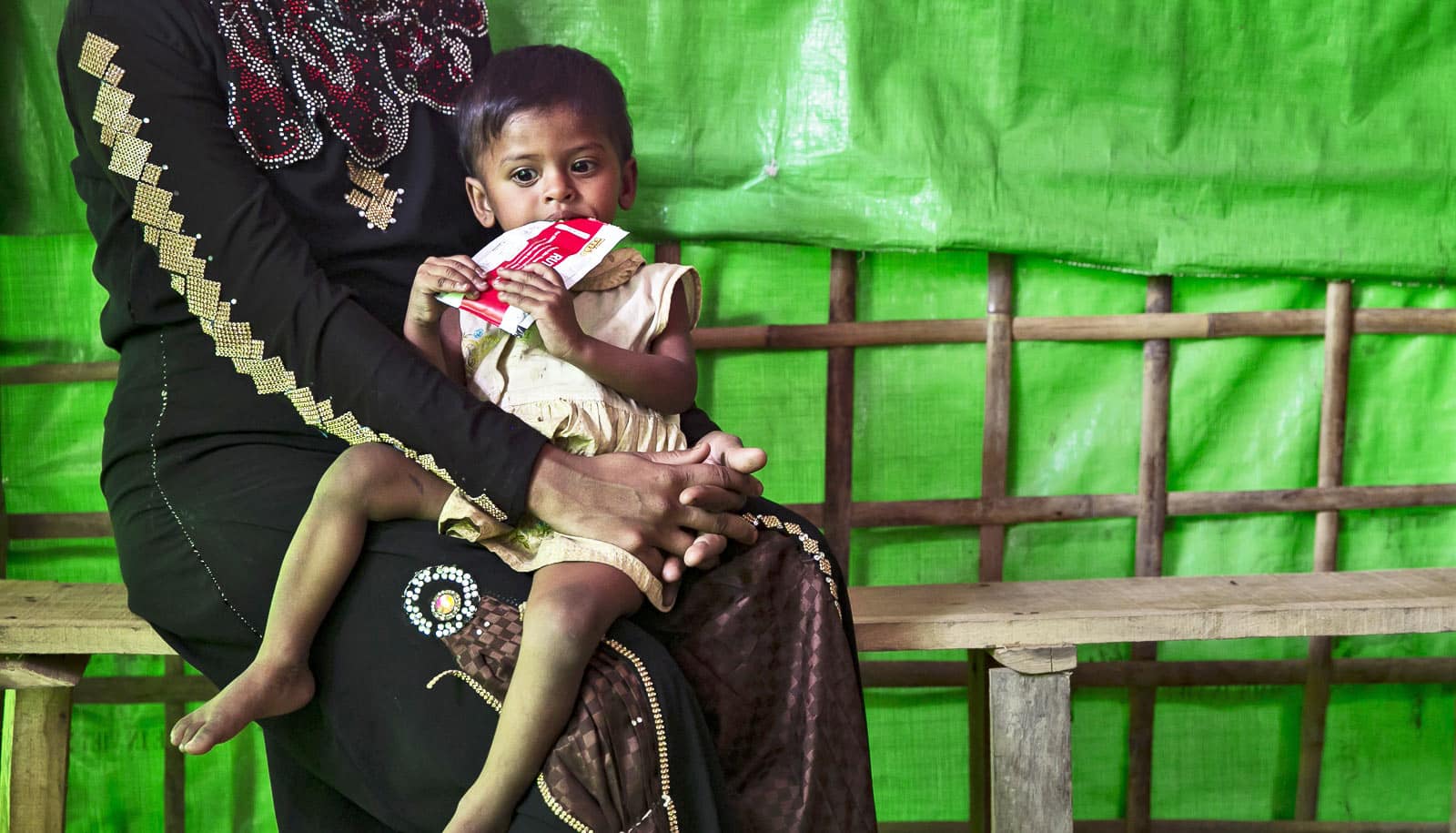A type of therapeutic food, specifically designed to repair the gut microbiomes of malnourished children, is superior to standard therapy, according to a clinical trial in Bangladesh.
The new approach to addressing the pressing global health problem of childhood malnutrition focuses on selectively boosting key growth-promoting gut microbes using ingredients present in affordable, culturally acceptable foods.
Reported in two studies in Science, the work supports the notion that healthy growth of infants and children is inexorably linked to healthy development of their gut communities following birth.
“We found that children who are malnourished have incompletely formed gut microbial communities compared with their healthy counterparts” says senior author Jeffrey I. Gordon, professor and director of the Edison Family Center for Genome Sciences & Systems Biology at the Washington University School of Medicine in St. Louis.
“Therefore, we set about to design therapeutic foods to repair this immaturity and to determine whether such repair would restore healthy growth.”
Twice a day
The clinical trial included 63 Bangladeshi children, 12-18 months of age, diagnosed with moderate acute malnutrition, meaning the children were ill but not close to death. Researchers randomly assigned the children to one of four treatment groups. Children in three of the groups each received one of the three newly designed therapeutic foods, while those in the fourth group received a standard therapeutic food not designed for its effects on the gut microbiome.
The International Centre for Diarrhoeal Disease Research locally produced all foods for the trial. Mothers brought the children twice daily to a nutritional rehabilitation center and administered the therapeutic foods under the supervision of health-care workers.
A set of measuring tools, developed through advances in genomic medicine, provided a new, much more comprehensive definition of molecular features associated with malnutrition, its underlying mechanisms, and the effectiveness of treatment.
The winning treatment
One of the therapeutic foods stood out from the rest, even in this relatively short one-month trial. When scientists measured 1,300 blood proteins, including those intimately involved in directing bone growth, development of the brain, immune function, and metabolism in various tissues, they found that this food prototype produced a pronounced shift toward a healthy state compared with what they observed in the other three groups of children.
At the end of the study, the researchers also found that, unlike in the three other treatment groups, the gut microbial communities residing in the intestines of children receiving this lead therapeutic food had undergone a reconfiguration and more closely resembled microbial communities found in age-matched healthy children living in the same locale.
The formulation contained, among other components, a mixture of nutrients from chickpeas, soy, bananas, and peanuts.
150 million children under 5
Childhood malnutrition is a massive global health problem, affecting 150 million children under age 5 worldwide, according to the World Health Organization. Many studies have shown that malnutrition is the result of many factors, with reliable access to adequate amounts of affordable, nutritious food being one but not the only factor.
Therapeutic foods exist to increase the amount of key nutrients children consume. Malnourished children who receive these foods are less likely to die, but other consequences of malnutrition have remained largely unresponsive to treatment, including stunted growth, impaired immunity, and reduced cognitive function. Scientists didn’t design these foods based on a consideration of their effects on the development of the gut microbiome, Gordon says.
The new microbiome-directed therapeutic foods emanated from earlier studies of gut microbial community development in healthy children living in Bangladesh.
Several years ago, researchers discovered that children with malnutrition had immature gut communities—ones that appeared younger than their age-matched healthy counterparts and researchers found that conventional therapeutic foods failed to repair this immaturity in the malnourished children they had treated, says Tahmeed Ahmed, the director of nutrition and clinical services at the International Centre for Diarrhoeal Disease Research.
Gordon’s group went on to transplant immature communities from malnourished children, and normally maturing communities from healthy children, into mice raised under sterile conditions. The results revealed that immature communities associated with reduced weight gain, defective bone development, plus abnormal metabolic and immune functions in the recipient animals. These findings provided early evidence that failure to form a normal microbial community may be a cause rather than simply an effect of malnutrition.
“There is uncertainty about what foods are best to administer during the period of complementary feeding—when children transition from exclusive milk feeding to solid foods,” Gordon says.
“Our studies were inspired by the notion that these commonly used, affordable, culturally acceptable complementary foods could contain ingredients coveted by key microbes that are underrepresented and underperforming in the gut microbiomes of malnourished children. These microbes were our therapeutic targets.”
Bone, brain, and immune system
The study provides the first evidence that a therapeutic food, developed specifically to support growth and expansion of gut microbes linked to healthy microbiome development, has beneficial effects outside the gut related to many aspects of healthy growth.
These effects involve key mediators of metabolism, and of bone, brain, and immune system development—organ systems that have been very difficult to repair in malnourished children by supplementing their diet with traditional therapeutic foods.
In the first paper, researchers describe how they first used germ-free mice, and then germ-free piglets, colonized with gut microbial community members from Bangladeshi children to screen a series of diets comprised of complementary food ingredients used in Bangladesh.
They formulated Microbiome-Directed Complementary Food prototypes that could repair immature microbial communities from malnourished Bangladeshi children in both these animal models and improve the health of the animals. Scientists then tested these prototypes in the double-blind controlled feeding study described above.
In the second paper, first author Arjun S. Raman describes development of new computational methods, based on methods originally developed by the field of econophysics to analyze how fluctuations in the economy affect features of complex, dynamic financial markets.
The approach provided new, generally applicable ways of characterizing the organization of human gut communities—their normal development, how they are perturbed in disease states such as malnutrition, and how they respond to therapeutic interventions designed to repair them.
“The goal of human microbiome research is not simply to describe the component parts of a microbial community but rather to characterize how the components interact with one another to shape community functions,” Gordon says. “Complicating matters, the number of possible interactions between the components in a gut community is literally astronomical.”
The researchers wanted to be able to focus their attention, finding ways to reduce the number of components or features of the microbiome to a minimum number that could portray in an informative way the organizational properties of healthy and diseased gut communities, Raman says.
Studying the microbiomes of healthy Bangladeshi children sampled monthly from birth through five years, and using the new computational method, they identified a network of 15 gut bacterial community members that consistently interacted with one another. They named this network an ecogroup.
Lasting benefits?
The components of the ecogroup provided an accurate way of describing normal gut development of infants and children living in Bangladesh as well as several other low-income countries. It further served as a sensitive and accurate way of determining how severely disrupted microbial communities are in children with moderate and severe malnutrition, and the degree to which they are repaired with various treatments.
“A longer and larger clinical trial is currently underway at two sites in Bangladesh to see if the new Microbiome-Directed Complementary Food has sustained benefits,” Ahmed says. “This trial includes children with moderate malnutrition as well as children with severe malnutrition treated with conventional therapy but left with incompletely repaired microbiomes, stunting and various other growth impairments.”
“It is possible that some children may have gut microbial communities so damaged that a food-based intervention alone won’t be sufficient. So our Washington University and International Centre for Diarrhoeal Disease Research team is interested in studying the possibility of giving the specific beneficial organisms—or even the beneficial products those microbes make, as we become more knowledgeable about what those are—in combination with a Microbiome-Directed Complementary Food.
“That could be a second line of defense. Our studies also present the possibility of monitoring development of gut microbial communities and catching deviations from normal development earlier in life, giving us opportunities for prevention.”
Efforts designed to repair the perturbed microbial communities of malnourished children hold the promise of revealing more informed guidelines for feeding children in the first several years of life so that they can develop healthy microbiomes, Gordon says.
“We need to be effective stewards of the precious microbial resources of our children. If we are, the effects may be long-lived and herald a new dimension to preventive medicine—one that starts with their developing microbiomes.”
The Bill & Melinda Gates Foundation, the National Institutes of Health, the Washington University School of Medicine Physician Scientist Training Program, the Russian Science Foundation, and Agilent Technologies supported the work.


